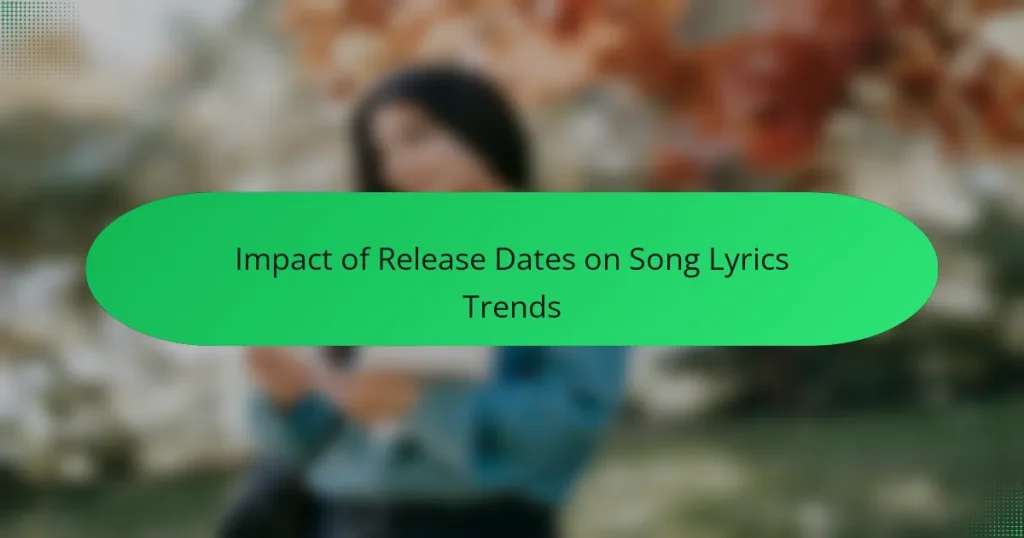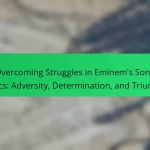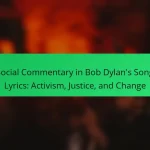Release dates significantly influence song lyrics trends, reflecting current social issues, cultural movements, and seasonal themes. Songs released during specific times, such as summer or winter, often exhibit distinct lyrical characteristics that resonate with listeners. Historical shifts in lyrical content demonstrate how societal changes, such as political movements and cultural developments, shape song themes over decades. Additionally, artists can strategically leverage release dates to enhance the emotional impact of their lyrics by aligning with relevant events or holidays. This article examines the correlation between release timing and lyrical trends, highlighting how contemporary issues and cultural contexts drive song popularity and listener engagement.
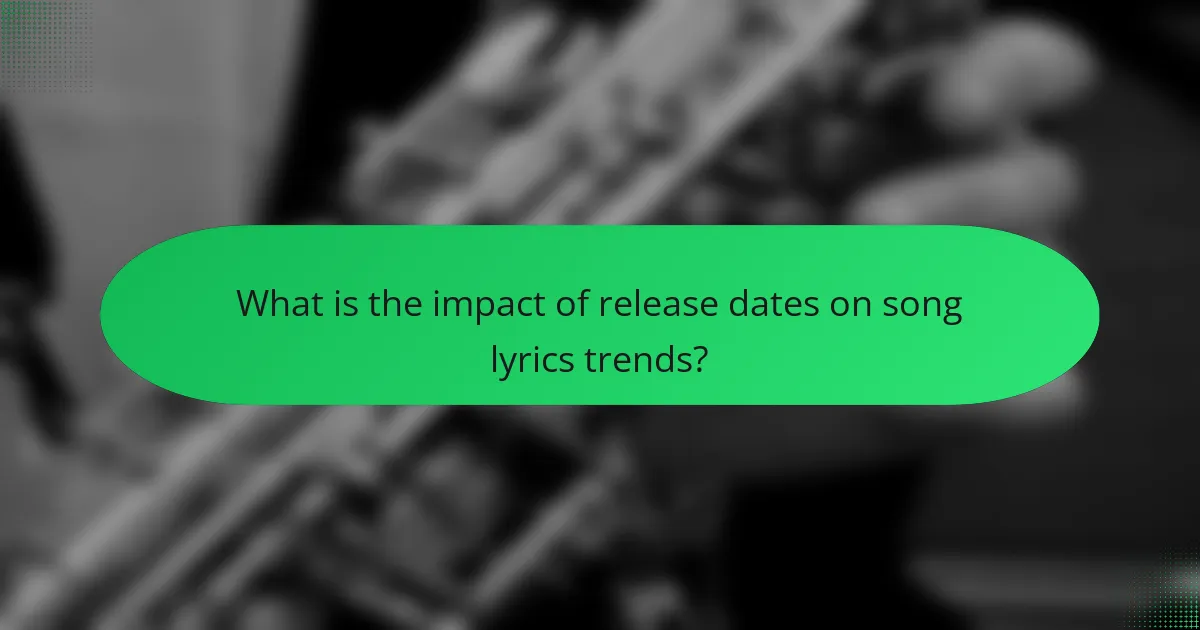
What is the impact of release dates on song lyrics trends?
Release dates significantly influence song lyrics trends. New releases often reflect current social issues, cultural movements, or seasonal themes. For example, songs released during summer frequently feature upbeat, carefree lyrics. Conversely, winter releases may evoke nostalgia or introspection. Additionally, timing can affect lyrical content based on events, such as political upheaval or global crises. Research shows that songs addressing contemporary issues often gain popularity quickly. A study by the University of Southern California found that lyrics responding to recent events resonate more with listeners. This correlation demonstrates the impact of release dates on the thematic direction of song lyrics.
How do release dates influence the themes of song lyrics?
Release dates significantly influence the themes of song lyrics. The timing of a song’s release can reflect current social, political, or cultural events. For example, songs released during times of social unrest often address themes of protest and change. Historical context, such as the civil rights movement or economic crises, shapes lyrical content. Additionally, seasonal releases can influence themes; summer songs often focus on joy and freedom, while winter releases may evoke nostalgia or reflection. Data shows that songs released during significant events often see increased relevance and listener engagement. This correlation highlights the importance of timing in shaping lyrical themes.
What are common themes in songs released during specific seasons?
Common themes in songs released during specific seasons include love, nostalgia, and celebration. Spring songs often focus on renewal and romance, reflecting themes of blossoming relationships. Summer tracks frequently highlight freedom, adventure, and fun, aligning with vacation and outdoor activities. Fall songs tend to evoke nostalgia and reflection, often addressing change and the passage of time. Winter songs typically explore themes of warmth, togetherness, and holiday spirit, emphasizing family and celebration. These seasonal themes are consistently observed in various music charts and playlists, illustrating how artists align their lyrics with seasonal sentiments.
How do cultural events correlate with song lyrics themes?
Cultural events significantly influence song lyrics themes. Events like political movements, social changes, and major historical occurrences shape the narratives in music. For instance, the civil rights movement in the 1960s inspired songs that addressed themes of equality and justice. Similarly, global events such as wars often lead to lyrics reflecting loss and resilience. The rise of social media has also changed how artists respond to current events, making lyrics more immediate and relevant. This correlation is evident in the way artists draw from their surroundings to create relatable content. Historical context provides a framework for understanding the emotional depth in song lyrics.
Why is timing important in the music industry?
Timing is crucial in the music industry as it influences a song’s success and audience reception. The release date can affect chart performance, streaming numbers, and overall visibility. For instance, launching a single during a holiday season can capitalize on increased consumer spending. Additionally, aligning releases with cultural events can enhance relevance and engagement. Historical data shows that songs released in the summer months often perform better due to increased outdoor activities and social gatherings. Timing also plays a role in avoiding competition with major releases, which can overshadow a new song. Overall, strategic timing can significantly impact a track’s commercial performance and longevity.
How do artists choose release dates for their songs?
Artists choose release dates for their songs based on several strategic factors. They consider market trends, audience availability, and competition. Timing a release around holidays or significant events can maximize exposure. Additionally, artists often analyze streaming patterns to determine optimal days for audience engagement. Collaborations with marketing teams also influence the final decision. For instance, releasing a song on a Friday aligns with industry standards for new music. This approach capitalizes on weekend listening habits. Ultimately, the goal is to enhance visibility and chart performance.
What role do marketing strategies play in determining release dates?
Marketing strategies significantly influence the determination of release dates. Companies analyze consumer behavior and market trends to identify optimal timing. For instance, releasing music during peak listening seasons can maximize exposure. Additionally, aligning releases with promotional events or holidays enhances visibility. Strategic timing can also help avoid competition with major artists. Historical data shows that albums released in the fourth quarter often see higher sales. Thus, marketing strategies play a crucial role in optimizing release dates for commercial success.
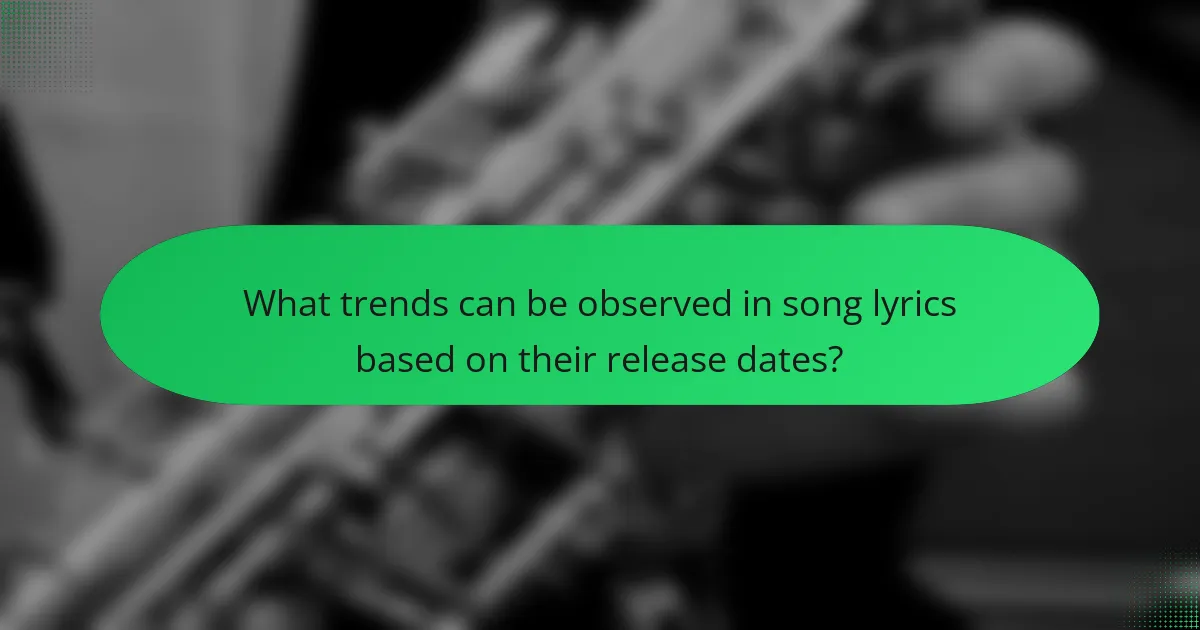
What trends can be observed in song lyrics based on their release dates?
Trends in song lyrics often reflect societal changes over time. Lyrics from the 1960s and 1970s frequently addressed social issues and political movements. In contrast, the 1980s saw a rise in themes of materialism and personal success. The 1990s introduced more introspective and emotional content, often exploring personal struggles. The 2000s shifted towards themes of empowerment and diversity. Recent years have shown an increase in mental health awareness and inclusivity in lyrics. These shifts correlate with significant cultural and technological developments, such as the rise of social media. Studies have shown that lyrics often mirror the emotional and social climate of their time. For instance, research by the University of California found that lyrical content is influenced by historical events and trends.
How do lyrics evolve over different time periods?
Lyrics evolve over different time periods through changes in cultural context, language, and societal norms. Historical events often influence lyrical themes. For example, the civil rights movement inspired protest songs in the 1960s. The rise of technology has also impacted lyrics, introducing new vocabulary and themes related to digital life.
In the 1980s, lyrics often reflected materialism and excess, influenced by the economic climate. The 1990s saw a shift towards introspection and emotional expression, particularly in genres like grunge. Contemporary lyrics frequently address issues like mental health and social justice, reflecting current societal concerns.
Trends in music genres also shape lyrical content. Hip-hop has evolved to include complex narratives and storytelling. Pop music often focuses on catchy hooks and relatable themes. Overall, the evolution of lyrics mirrors broader cultural shifts and technological advancements.
What historical events have influenced lyrical content?
Historical events significantly influence lyrical content in music. Major wars often inspire themes of loss and resilience. For instance, World War II prompted many songs reflecting hope and sorrow. The civil rights movement led to powerful anthems advocating for equality and justice. Events like the Vietnam War resulted in protest songs expressing dissent and disillusionment. Economic crises also shape lyrics, with artists addressing struggles and societal issues. The rise of technology has influenced lyrical themes related to modern life and connectivity. Each of these events provides context that shapes the messages conveyed in music.
How do societal changes reflect in song lyrics trends?
Societal changes are often mirrored in song lyrics trends. Lyrics can reflect cultural shifts, political movements, and social issues. For example, during the civil rights movement, songs like “A Change Is Gonna Come” by Sam Cooke expressed the struggles for equality. In recent years, themes of mental health and social justice have gained prominence in lyrics. This shift aligns with growing public discourse on these topics. Additionally, the rise of digital platforms has influenced lyrical content by making diverse voices more accessible. The evolution of language and slang in lyrics also reflects changing societal norms. Overall, song lyrics serve as a barometer for societal sentiment and change over time.
What are the differences in lyrics between songs released in various genres?
Songs released in various genres differ significantly in their lyrics. Pop songs often focus on themes of love and relationships, using catchy hooks and repetitive structures. In contrast, rock lyrics may explore themes of rebellion, personal struggle, and social issues, often featuring more complex narratives. Hip-hop lyrics frequently emphasize storytelling, cultural commentary, and personal experience, utilizing rhythm and rhyme as key elements. Country music lyrics typically reflect storytelling about everyday life, love, and heartache, often with a narrative structure.
Additionally, electronic music lyrics may be minimalistic, focusing on mood and atmosphere rather than storytelling. The differences in lyrical content are influenced by the cultural context and audience expectations of each genre. For example, the lyrical depth in folk music often addresses social and political issues, while R&B lyrics tend to emphasize emotional expression and intimacy. These distinctions highlight how genre shapes the themes, structures, and styles of song lyrics across the music landscape.
How does genre affect the lyrical themes related to release dates?
Genre significantly influences lyrical themes associated with release dates. Different genres often reflect the cultural and social contexts of their time. For example, hip-hop frequently addresses contemporary social issues, while country music may focus on personal storytelling and nostalgia.
The timing of a song’s release can also align with seasonal themes. Holiday music typically emerges in the months leading up to specific celebrations. This alignment affects the lyrical content, as artists tailor their messages to resonate with listeners’ current experiences.
Moreover, genres evolve over time, leading to shifts in lyrical themes. For instance, rock lyrics from the 1960s often reflected countercultural movements, while modern rock may address personal struggles or technological impacts.
Statistical analysis of song lyrics shows that themes shift in response to major societal events. For example, during economic downturns, genres like pop may incorporate themes of resilience and hope. In contrast, genres like punk may express discontent or rebellion.
Overall, genre shapes how artists respond to their environment, influencing lyrical themes in relation to release dates.
What trends are unique to specific music genres based on release timing?
Certain music genres exhibit unique trends based on release timing. For example, pop music often sees a spike in releases during summer months. This aligns with the genre’s association with upbeat, feel-good themes suitable for warmer weather. Conversely, rock music frequently releases albums in the fall. This timing capitalizes on the back-to-school season, appealing to a demographic seeking nostalgia and introspection.
Hip-hop tends to have a more varied release schedule. Major albums often drop in late spring or early summer, coinciding with festival season. This maximizes exposure and audience engagement. Country music typically sees releases in the late summer or early fall, aligning with harvest themes prevalent in its lyrical content.
Data from the Billboard charts indicates these seasonal patterns. For instance, a significant number of top-charting pop songs were released in June and July. Similarly, rock albums released in September often perform well, leveraging the new school year. These trends demonstrate how release timing is strategically aligned with genre characteristics and audience behavior.
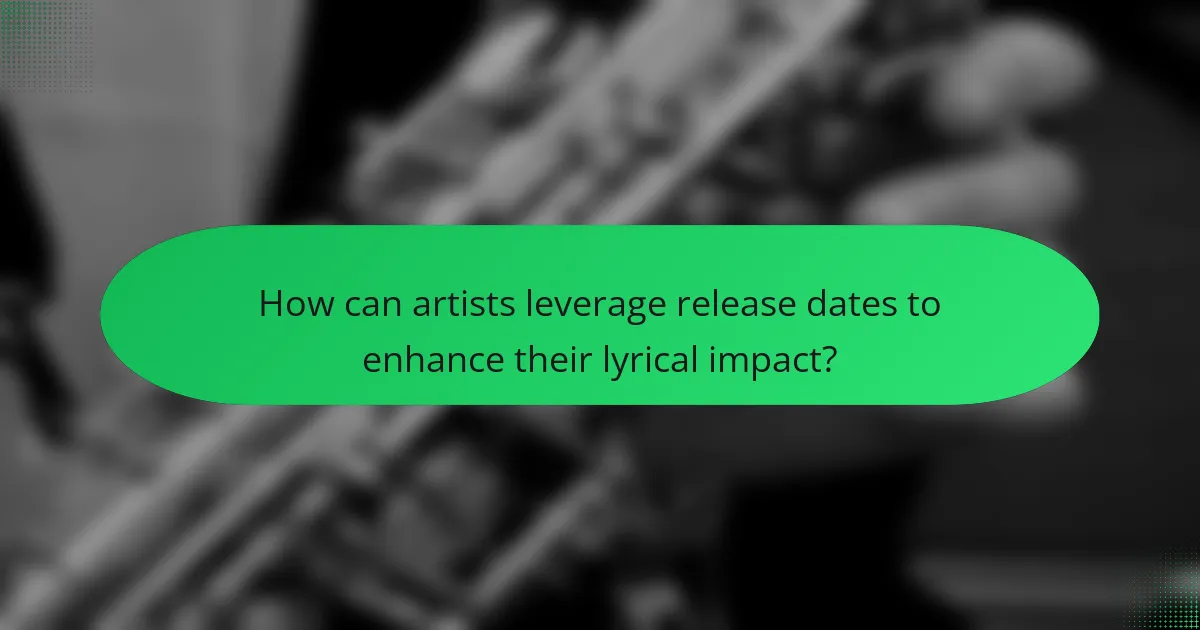
How can artists leverage release dates to enhance their lyrical impact?
Artists can leverage release dates to enhance their lyrical impact by aligning their music with relevant cultural events. Timing releases to coincide with holidays or significant social movements can amplify the emotional resonance of lyrics. For instance, releasing a song about love on Valentine’s Day can increase listener engagement. Additionally, artists can use strategic timing to capitalize on trending topics, ensuring their lyrics feel timely and relevant. Historical examples include songs that gained popularity during protests, where lyrics resonated with the collective sentiment. This alignment creates a deeper connection between the artist’s message and the audience’s experiences. By thoughtfully choosing release dates, artists can maximize the impact of their lyrical content.
What strategies can artists use to align their lyrics with current trends?
Artists can align their lyrics with current trends by analyzing popular themes and topics in contemporary music. They can utilize social media platforms to gauge audience interests and preferences. Collaborating with trendsetting producers can also help in crafting relevant soundscapes. Additionally, studying the lyrics of chart-topping songs provides insight into successful phrasing and storytelling techniques. Keeping an eye on cultural events and movements ensures that artists remain timely and relatable. Furthermore, engaging with fans through polls or feedback can refine lyrical content to better match listener expectations. Regularly updating their creative processes based on current trends fosters ongoing relevance in the music industry.
How can artists analyze past release dates to inform future projects?
Artists can analyze past release dates to inform future projects by examining trends in timing and audience reception. By studying when previous works were released, artists can identify peak periods for their genre. This analysis helps in understanding seasonal and cultural factors that influence listener engagement. For instance, songs released during summer months often perform better due to increased outdoor activities.
Additionally, artists can track the release dates of similar artists to gauge competition and market saturation. Historical data shows that major artists often release new albums in the fall to align with award seasons. Analyzing the success of these releases provides insight into optimal timing for new projects.
Moreover, artists can utilize analytics tools to measure the performance of past releases. Metrics such as streaming numbers and chart positions can reveal how release timing affected audience response. This data-driven approach allows artists to make informed decisions for future projects.
What tools can artists use to track lyrical trends over time?
Artists can use tools like Google Trends, Spotify Analytics, and Genius to track lyrical trends over time. Google Trends allows users to analyze search interest in specific lyrics or themes. Spotify Analytics provides data on song performance, including listener demographics. Genius offers insights into popular lyrics and annotations that highlight trending topics. These tools help artists understand how lyrical themes evolve. They also identify shifts in audience preferences. By analyzing this data, artists can adapt their songwriting to align with current trends. This approach enhances their relevance in a competitive music industry.
What best practices should artists follow when planning song releases?
Artists should follow a structured approach when planning song releases. This includes setting a strategic release date. Research indicates that timing can significantly influence listener engagement. Artists should also promote their songs in advance through social media and email newsletters. Engaging with fans prior to release builds anticipation. Collaborating with influencers can enhance visibility. Additionally, artists should consider digital distribution platforms for wider reach. Analyzing data from previous releases can inform future strategies. Consistent branding across promotional materials is essential for recognition.
How can understanding release date trends improve song reception?
Understanding release date trends can significantly improve song reception. By analyzing historical data, artists can identify peak listening periods. For example, songs released during summer months often perform better due to increased outdoor activities. Additionally, aligning releases with holidays or events can enhance visibility. Research shows that songs released on Fridays tend to chart higher, as listeners are more engaged during weekends. This strategic timing can lead to increased streams and sales. Ultimately, understanding these trends allows artists and labels to optimize their marketing efforts for maximum impact.
What common mistakes should artists avoid regarding release timing?
Artists should avoid releasing music during major holidays or events. This timing can overshadow their work due to competing interests. Additionally, artists often make the mistake of not considering the day of the week. Studies show that Fridays yield higher streaming numbers. Another common error is neglecting to align releases with promotional campaigns. A well-timed release can maximize visibility and engagement. Artists should also avoid last-minute decisions on release dates. Planning ahead allows for better marketing strategies. Lastly, ignoring audience feedback on preferred release times can hinder success. Engaging with fans can provide valuable insights into optimal timing.
The main entity of this article is the impact of release dates on song lyrics trends. The article explores how release timing influences lyrical themes, reflecting social, cultural, and seasonal contexts. It discusses the correlation between contemporary events and song popularity, highlighting common themes across different seasons and genres. Additionally, it examines strategies artists can employ to optimize release dates for maximum engagement and relevance, while also analyzing historical trends to inform future projects. Overall, the content provides a comprehensive overview of the relationship between release dates and the thematic evolution of song lyrics.
